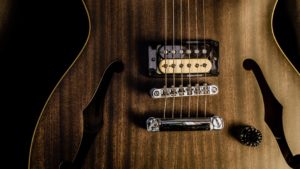
By Phil Raymond, Staff Writer
Perhaps one of the most iconic guitar brand names in the marketplace, “Gibson,” is facing financial difficulties, and by summer 2018 it could either be under new management or be completely bankrupt.
Beginning its life in Kalamazoo, Michigan in 1902,[1] Gibson quickly grew to became one of the most recognized names in music. Despite rising to the forefront of guitar manufacturing – touting associations with legendary guitar acts such as Jimmy Page, “Slash,” Angus Young of AC/DC, and Billy Gibbons of ZZ Top[2] – the manufacturer has a debt problem.
In late 2017, Gibson began making the wrong kinds of headlines. The first major story broke in August 2017, when “Moody’s,” a major tool for investors that provides credit rating services and research analysis on financial markets,[3] downgraded Gibson’s Credit Rating Definition (“CFR”) from Caa2 to Caa3.[4] A Caa3 rating on the Moody’s’ scale indicates that a company’s obligations are “judged to be of poor standing and are subject to very high credit risk.”[5]
The downgrade was in response to Gibson’s acquisition of nearly $520 million dollars in debt that is rapidly approaching maturity. Moody’s indicated that Gibson’s $375 million of outstanding senior secured notes will mature on August 1, 2018, and an additional $145 million of outstanding secured bank loans will become due July 23, 2018 if the notes are not refinanced by the August deadline.[6]
Gibson’s troubles arise from problems that it caused itself, as well as distinct issues caused by the nature of its business. The company made a series of acquisitions of electronic companies over the years which required it to acquire substantial debt in order to fund the transactions.[7] While acquiring this debt is not per se detrimental to a company, it becomes a problem when a company has insufficient cash flow to eliminate and pay off the debt as it becomes due.
Investment firms may employ the use of Earnings Before Interest, Taxes, Depreciation, and Amortization (“EBITDA”),[8] a metric used to evaluate a company’s operating performance, while excluding non-operating expenses and certain non-cash expenses. When a company maintains a high debt:EBITDA ratio, the company is highly-likely to default on debt and be unable to pay when it comes due. Ratios higher than 4 or 5 are worrisome because it indicates a company is less likely to be able to handle its debt burden, and thus is less likely to be able to take on the additional debt required to grow the business.[9]
In Gibson’s case, because of its past debt-funded acquisitions, Moody’s described Gibson’s financial status as “high leverage,” at around 10 times debt:EBITDA ratio.[10]
Another reason Moody’s downgraded Gibson is management, specifically relating to high turnover rates in the company’s senior financial management team.[11] In recent news, investors have been imploring Gibson to hire a new CEO to replace existing CEO Henry Juszkiewicz. A group of debtholders advised by PJT Partners Inc., who reportedly own two-thirds of Gibson’s outstanding debt notes due in August 2018, is looking to restructure the company in a way that grants them ownership of Gibson and allows them to establish new leadership.[12]
The need for change, as a recent Bloomberg report states, comes from the fact that “the holders don’t expect Gibson’s earnings will be strong enough to attract new money for a refinancing to head off a default looming later this year, and creditors are reluctant to invest more funds while Juszkiewicz is still in charge.”[13] It remains to be seen whom, if anyone, will be brought in to revitalize the guitar manufacturer’s earnings.
Turning to the nature of the business, the Moody’s downgrade was also attributed to the highly-discretionary nature of Gibson’s product lines.[14] Gibson not only faces competition from a variety of boutique guitar manufacturers offering impressive products at a fraction of the cost, it also faces the harsh reality that consumers are not buying guitars like they used to.[15] When Gibson rose to prominence, it was backed by a musical scene dominated by famous guitar players that were emulated by millions of fans. Today, only a handful of name-recognized guitar players remain, and audience interest has shifted elsewhere. The changing atmosphere of the music scene today may play a part, but it is Gibson’s overall battle to stay relevant that is giving investors pause.
Whether a complete change in executive personnel will help Gibson out of its debt-laden position remains unclear. But what is sharply evident is that time is quickly running out for the iconic guitar manufacturer to attract new investors.
Sources
[1] http://www.wideopencountry.com/gibson-guitars-bankrupt/
[2] https://spinditty.com/industry/Famous-Gibson-Les-Paul-Players
[3] https://www.moodys.com/Pages/atc.aspx
[4] https://www.moodys.com/research/Moodys-downgrades-Gibsons-CFR-to-Caa3-outlook-negative–PR_371298
[5] https://www.moodys.com/sites/products/ProductAttachments/AP075378_1_1408_KI.pdf
[6] https://www.moodys.com/research/Moodys-downgrades-Gibsons-CFR-to-Caa3-outlook-negative–PR_371298
[7] http://www.latimes.com/entertainment/music/la-et-ms-gibson-brands-guitar-henry-juszkiewicz-20170618-htmlstory.html
[8] https://www.investopedia.com/articles/06/ebitda.asp
[9] https://www.investopedia.com/terms/n/net-debt-to-ebitda-ratio.asp
[10] https://www.moodys.com/research/Moodys-downgrades-Gibsons-CFR-to-Caa3-outlook-negative–PR_371298
[11] Id.
[12] http://www.whio.com/business/investors-want-new-ceo-gibson/oFwX6RtR1AZr64OFIKAkXP/
[13] https://www.bloomberg.com/news/articles/2018-02-20/gibson-creditors-are-said-to-want-new-ceo-before-funding-rescue
[14] https://www.moodys.com/research/Moodys-downgrades-Gibsons-CFR-to-Caa3-outlook-negative–PR_371298
[15] https://qz.com/1013293/rock-and-roll-is-dead-sales-of-fender-and-gibson-electric-guitars-prove-it/